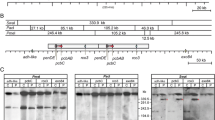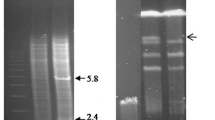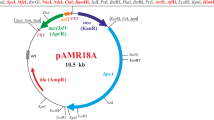Abstract
Previous workers have shown that some strains ofAspergillus nidulans produce penicillin-like substances. In the present studies, shake-flask cultures of 101 wild-type strains ofA. nidulans, representatives of 18 different heterokaryon-compatible groups, were examined and filtrates of most found to inhibit the growth of a strain ofBacillus subtilis sensitive to penicillin, although members of two of these groups had no detectable antibiotic activity. Five strains with antibacterial properties were chosen for detailed investigation as well as two genetically labelled derivatives obtained from one of these after ultraviolet light treatments; one derivative had a similar antibiotic yield to its original wild-type parent but the other was selected as having increased antibiotic yield. The antibiotic produced by these seven strains was by all tested criteria, including chromatographic and electrophoretic behaviour, indistinguishable from penicillin. A heterokaryon test between the two mutants indicated that antibiotic productivity was under nuclear control.
Similar content being viewed by others
References
Abraham, E. P. andTrown, P. W. 1963. Structure and synthesis of cephalosporidine, a degradation product of cephalosporin C. Biochem. J.86: 271–277.
Batchelor, F. R., Doyle, F. P., Nayler, J. H. C. andRolinson, G. N. 1959. Synthesis of penicillin: 6-aminopenicillanic acid in penicillin fermentations. Nature183: 257–258.
Brownlee, K. A., Loraine, P. K. andStephens, J. 1949. The biological assay of penicillin by a modified plate method. J. Gen. Microbiol.3: 347–352.
Demerec, M., Adelberg, E. A., Clark, A. J. andHartman, P. E. 1966. A proposal for a uniform nomenclature in bacterial genetics. Genetics54: 61–76.
Dorn, G. L. 1967. A revised map of the eight linkage groups ofAspergillus nidulans, Genetics56: 619–631.
Dulaney, E. L. 1947a. Some aspects of penicillin production byAspergillus nidulans. Mycologia39: 570–581.
Dulaney, E. L. 1947b. Penicillin production by theAspergillus nidulans group. Mycologia39: 582–586.
Foster, J. W. andKarow, E. O. 1945. Microbiological aspects of penicillin. VIII. Penicillin from different fungi. J. Bacteriol.49: 19–29.
Grindle, M. 1963a. Heterokaryon compatibility of unrelated strains in theAspergillus nidulans group. Heredity18: 191–204.
Grindle, M. 1963b. Heterokaryon compatibility of closely related wild isolates ofAspergillus nidulans. Heredity18: 397–405.
Hale, C. W., Newton, G. G. F. andAbraham, E. P. 1961. Derivatives of cephalosporin C formed with certain heterocyclic tertiary bases. Biochem. J.79: 403–408.
Jinks, J. L. 1954. Somatic selection in fungi. Nature174: 409–410.
Jinks, J. L. 1956. Naturally occurring cytoplasmic changes in fungi. C. R. Lab. Carisberg Ser. physiol.26: 183–203.
Jinks, J. L., Caten, C. E., Simchen, G. andCroft, J. H. 1966. Heterokaryon incompatibility and variation in wild populations ofAspergillus nidulans. Heredity21: 227–239.
Kafer, E. 1958. An 8-chromosome map ofAspergillus nidulans. Advan. Genet.9: 105–145.
McCully, K. S. andForbes, E. C. 1965. The use ofp-fluorophenylalanine with ‘master strains’ ofAspergillus nidulans for assigning genes to linkage groups. Genet. Res. Camb.6: 352–359.
Macdonald, K. D., Hutchinson, J. M. andGillett, W. A. 1963. Isolation of auxotrophs ofPenicillium chrysogenum and their penicillin yields. J. Gen. Microbiol.33: 365–374.
Newton, G. G. F. andAbraham, E. P. 1954. Degradation, structure and some derivatives of cephalosporin N. Biochem. J.58: 103–111.
Pontecorvo, G., Roper, J. A., Hemmons, L. M., Macdonald, K. D. andBufton, A. W. J. 1953. The genetics ofAspergillus nidulans. Advan. Genet.5: 141–238.
Pontecorvo, G. andKafer, E. 1958. Genetic analysis based on mitotic recombination. Advan. Genet.9: 71–104.
Author information
Authors and Affiliations
Rights and permissions
About this article
Cite this article
Holt, G., Macdonald, K.D. Penicillin production and its mode of inheritance inAspergillus nidulans . Antonie van Leeuwenhoek 34, 409–416 (1968). https://doi.org/10.1007/BF02046463
Received:
Published:
Issue Date:
DOI: https://doi.org/10.1007/BF02046463




